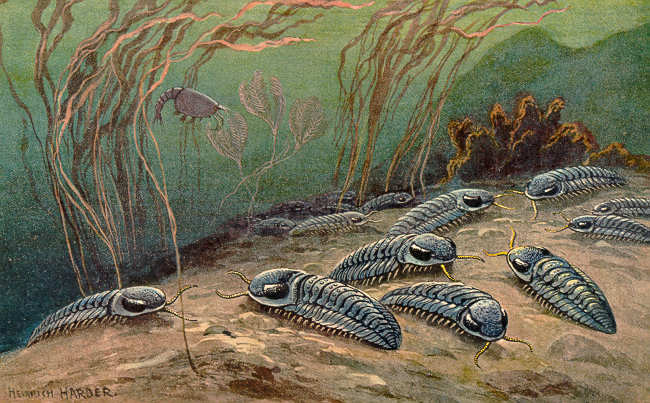Unless otherwise noted, the material on this page may be used under the terms of a
Creative Commons License.
| Trilobita | ||
| Arthropoda | Trilobita |
| Arachnida | Arthropoda | ||
| Arachnida | Trilobita | Mandibulata |
| Class Trilobita Order Agnostida Order Redlichiida Order Corynexochida Order Phacopida Order Lichida Order Proetida Order Harpetida Order Ptychopariida Order Asaphida Order Odontopleurida Order Nectaspida |
Trilobites Trilobite Systematics and Taxonomy Trilobites Through Geologic Time Trilobite Gallery Glossary References |

Middle Cambrian trilobites (Artwork by Heinrich Harder, 1916, from Geology in Art)
Trilobites comprise a complex and huge clade of arthropods with estimates of number of species ranging up to 20,000 thousand among some 5000 genera, 150 families, and nine distinct orders. There are 10 orders if Odontopleurida is erected from Order Lichida, and 11 if the Nektaspida (commonly called soft-bodied trilobites are classified as a trilobite order). Trilobites burst into amazingly diversity in the fossil record within some five million years of the base of the Cambrian. Such diversity is evidence that trilobites had a past dating long before this famous period and its apparent explosion of life known as the Cambrian Explosion. What made them seem new was that they had acquired a readily preserved skeleton, one they had to be shed to grow. Trilobite progenitors with soft bodies had died and decomposed leaving no trace. Trilobites radiated into the most diverse class of extinct creatures during the Paleozoic, but the Cambrian marked their middle age, not their beginnings. Their size ranged from less than a mm to over one meter in length. The made their living in diverse ways, some crawling, some swimming ,and some living a planktonic existence. They were detritivores, predators, and scavengers, and evolved stealthy and defensive phenotypic characteristics in order to survive in an evolutionary arms race between predator and prey. When they appearin the Cambrian fossil record they are not only diverse in form, and dispersed in geography across all continents. Among the Cambrian fauna, the crystal eyes of trilobites are unique. In the eyes is a strong clue of their ancestry in deep time of the Precambrian, since the fossil record indicates pre-sight neural tissue existed in forms of worms that also contain segmented morphology retained in the trilobite body plan.. RGP111204
page MAK111205